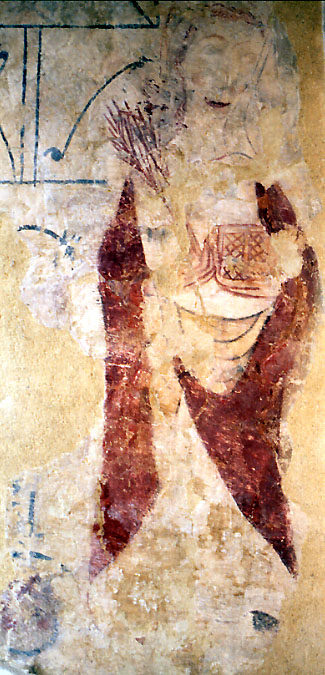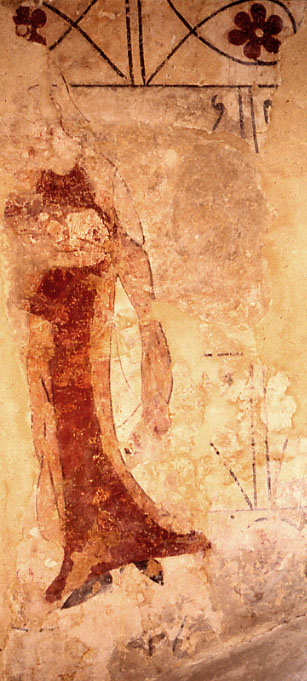Willingham, Cambridgeshire (Ely) mid C.13
St Etheldreda and Another Saint (Sexburga?)

Suffolk-born (probably at Exning) Etheldreda was a princess, the daughter of King Anna of East Anglia. Married twice, she managed, despite some resistance, to remain chaste within both marriages, and was eventually able to pursue her true vocation as a nun. In 673 she founded a double monastery at Ely, on the site of the present-day cathedral. She is not unknown to art by any means, appearing on at least six screens in East Anglia, but this is the only wall painting of her known to me, and it is the earliest of the paintings, which span more than three centuries, in the church at Willingham.
In her left hand is a book with an elaborate cover, and in her right she holds two palm branches, although she was not a martyr in the usual sense of the word. Etheldreda actually died of plague, during an outbreak which carried off several members of her community. A tumour in her neck, caused by her illness, was removed by her doctor, and when her uncorrupted body was examined seventeen years later, the wound from the surgery was found to have healed.

Although Etheldreda is sometimes shown as an Abbess, holding a pastoral staff, at Willingham the emphasis is on the miraculous post-mortem healing of the wound in her neck – what looks at first glance like a rather clumsily painted red mouth is in fact the livid scar left – in life, at any rate – after the surgery.
The saint (also known familiarly as St Audrey in England) attributed the neck tumour to divine punishment for her youthful fondness for necklaces – the ‘tawdry lace’ promised to the shepherdess Mopsa in Shakespeare’s Winter’s Tale¹ is a direct reference to the lace necklaces sold cheaply at St Audrey’s fairs, usually held in late June.
Etheldreda is in a window-splay on the west wall of the south aisle, and in the splay opposite is a painting of another female saint. She has never been conclusively identified, but I suspect that she might be St Sexburga, Etheldreda’s sister and her immediate successor as Abbess of Ely. She is far less clear than Etheldreda, but her blue shoes, and her elegantly draped robe, looped over her left arm, show well. Like Etheldreda, she wears a veil over her head and carries a book in her left hand.
Painted on the background is a ‘stoning and roses’ pattern incorporating delicate tendrils of foliage – an early example of this kind of design.
There are many more paintings at Willingham; not all are medieval, but those from the early 17th century provide an interesting insight into the way attitudes to church decoration changed after the Reformation. The fine medieval St Christopher is newly on the site, more will be added in due course, and the link below will take you to the website of Willingham church, where many of the others can be seen.
Website of Willingham church, Cambridgeshire
¹ Shakespeare, The Winter’s Tale, 1V, 1